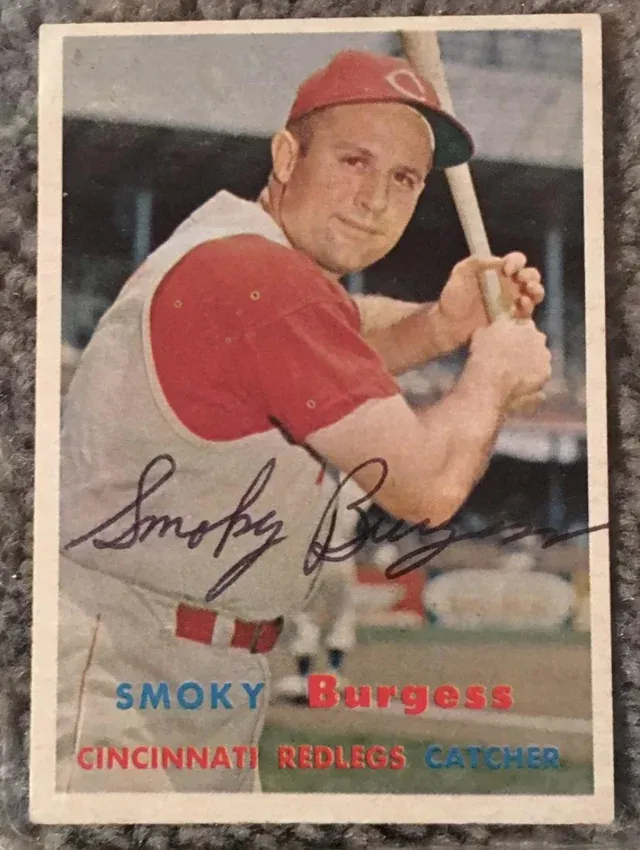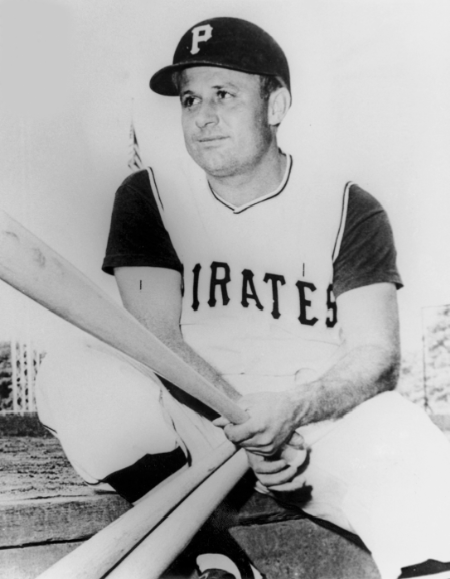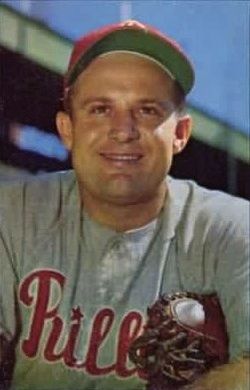Panoramic Photo Above:
Forbes Field, Pittsburgh

Baseball History Comes Alive Now Ranked As a Top Five Website by Feedspot Among All Baseball History Websites and Blogs!
(Check out Feedspot's list of the Top 35 Baseball History websites and blogs)
Guest Submissions from Our Readers Always Welcome! Click for details
Visit the Baseball History Comes Alive Home Page
Subscribe to Baseball History Comes Alive
Free Bonus for Subscribing:
Gary’s Handy Dandy World Series Reference Guide
Lets face it…the old pinch hitters (from the pre-DH era) are the Rodney Dangerfields of baseball: they get no respect! Today, Mark Kolier sets the record straight with an interesting essay about one of the best pinch hitters of all time: Smoky Burgess. I think you’ll enjoy what Mark has for us today. – GL
Another Edition of Baseball’s Forgotten Stars!
Smoky Burgess and His Bat Got Around
Have bat, can catch, will travel!
Had he not received the nickname “Smoky”, Forrest Harrill Burgess would not be remembered as well. I mean, is anyone named “Smoky” anymore? The derivation of his Smoky nickname is uncertain, but more on that later. A nine-time All-Star, Smoky Burgess’ excellence as a catcher and later, pinch-hitter, was remarkably consistent. It’s not politically correct (at least not like when he played) to call Smoky fat, but at 5’ 8”, listed at 185 pounds (but being well over 225 pounds), Burgess looked like what you thought a catcher would look like.
One thing was always for certain is the man could flat out hit. From a good SABR biography by Andy Sturgill
You could wake (Burgess) up at 3 a.m. on Christmas morning, with two inches of snow on the ground, throw him a curveball, and he’d hit a line drive.” – Joe Garagiola
His career bWAR* of 33.3 over 18 seasons averages out to under 2 bWAR per season which doesn’t merit serious Cooperstown consideration. He did average 3.3 bWAR/162 games which starts to get a little interesting since it indicates he didn’t play close to a full season on average playing in just under 60% of his team’s games in an average season. Pinch-hitting in 606 of his 1,692 career games, Burgess held many pinch-hitting records playing in the era before the DH debuted in 1973.
Burgess is another “Almost” guy for the Hall-of-Fame, but teams wanted him
Burgess was a catcher that could hit. That was as rare when he played as it is today. By his own description also from Andy Sturgill,
“I’m no Roy Campanella… But I’ll tell you one thing. I’m not as bad a catcher as most people think.”
His Baseball-Reference page notes that Smoky Burgess was a nine-time All-Star. Knowing that Burgess was a catcher, nine times seemed like a lot and got my attention since he played in the era of HOFer Roy Campanella (through 1957) being in the National League. There’s not much to compare when pitting Burgess against Roy Campanella.
Burgess also played his final season when future-HOFer Johnny Bench had his rookie season in 1967 and is a bridge between HOFers. Upon closer examination, his nine ASGs was a result of there being two All-Star Games in 1959-62 to raise money for the players’ pension fund. Burgess had six of his nine All-Star Game appearance from 1959-1961.
Have bat will travel!
Smoky and his trusty bat began his career with the Cubs (1949, 1951). Over his career, he spent six years in Pittsburgh, four years in both Cincinnati and Philadelphia (Phillies), and then two years in Chicago (White Sox) to close out his career.

Despite not comparing well with HOFer Campenella, Burgess’ career stats are well above what would be expected for even the best hitting catchers.
Although Smoky caught more than 100 games only five times in his career, he did catch 67% (1,141) of the games in which he appeared. As his career progressed, Burgess did so much pinch hitting that for a time he held the record with 585 career pinch hit appearances and as well as the record of 145 career pinch hits before it was broken by Manny Mota in 1975. Lenny Harris is the current record holder for games as a pinch hitter (883) and pinch hits (204). Burgess had 233 pinch hit appearances in his final three seasons and posted a .368 batting average in 1954, which would have won the NL batting crown, but he did not have enough at-bats to qualify.
The only other Smoky I immediately can think of is Smoky “Joe Wood”
Joe Wood got his nickname because he threw amazingly hard. The origin of Smoky Burgess’ name is less certain. He hailed from western North Carolina not far from the Great Smoky Mountains. So, there’s that. The nickname also might’ve come from his father, but he never smoked or drank being a strict Baptist. Only his wife Margaret called him Forrest which seems just right for 1940’s America.
The SABR story of what happened before he met Margaret is interesting, but mainly when you count the number of Forrests and Forests, considering Smoky’s actual first name.
Burgess grew up as a fan of the Yankees and especially their catcher Bill Dickey, primarily because Smoky was able to get their games on the radio in North Carolina. He attended Tri High School in Caroleen where he played the infield and led off. His high-school coach Forrest Hunt, who had caught in the minor leagues for the Yankees, gave him a piece of advice that influenced his approach to the game for the rest of his career: “You’ll never be a hitter unless you swing the bat.” In addition to playing for the high-school team, Smoky played for the Shelby and Forest Hills American Legion teams from 1942-44. Smoky signed with the St. Louis Cardinals in 1943 but was determined to be too young by Commissioner Landis, and the deal was voided. A year later he accepted a contract offer from the Chicago Cubs, but Smoky later claimed that this was in large part because the Cubs were interested in signing his brother Grady. Signing bonus in hand, Burgess purchased a new Mercury to ride around Forest City.
So many Forrest’s and Forests, no? There’s a “seeing the forest for the trees” metaphor in there but I just can’t quite figure out what that might be.
As I’ve noted before, pinch-hitters don’t get voted into Cooperstown. And because Smoky Burgess was such a renowned pinch-hitter after his catching career, he’s better remembered for it than he is as a catcher.
Catchers today are defense first and if they can hit, that’s a bonus. With the advent of ABS starting with the challenge system in 2026, catcher’s roles are going to change since pitch framing will ultimately disappear. Catchers who are good hitters will be more important.
Good hitting catchers and legendary pinch hitters do get around – just like Smoky Burgess.
Mark Kolier
About the Author: Mark Kolier along with his son Gordon co-hosts a baseball podcast called ‘Almost Cooperstown’. He also has written baseball-related articles that can be accessed on Medium.com and now Substack.com.
*bWAR: the Baseball Reference version of Wins Above Replacement, which includes pitching and defensive performances
Subscribe to Baseball History Comes Alive. FREE BONUS for subscribing: Gary’s Handy Dandy World Series Reference Guide. https://wp.me/P7a04E-2he




The thing I most remember about Smokey Burgess is that he was twice traded for Andy Seminick, once from the Reds to the Phillies and then back from the Phillies to the Reds three and a half years later. Burgess also played a role in Game 7 of the 1960 World Series. With the Pittsburgh down 5-4, Burgess led off the bottom of the 7th with a single. Because he was slow afoot (he didn’t get his nickname because he burned up the bases) and it was a one run game at the time, Joe Christopher pinch ran for him. Christopher didn’t score and Hal Smith replaced Burgess as catcher. In the bottom of the 8th, Smith hit a 3 run home run which not only gave the Bucs a 9-7 lead but also caused Casey Stengel to replace Jim Coates with Ralph Terry. Terry got out of the inning but hung a curve ball to Bill Mazeroski to start the bottom of the 9th. Burgess is slow, ergo, Pittsburgh wins the series.
Great essay.
Thanks Vince…interesting information!